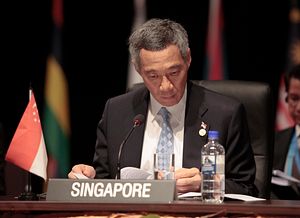In 2019, Singapore witnessed a new team of ministers — the fourth generation since political independence in 1965 — actively participate in policymaking and implementation. The People’s Action Party’s (PAP) approach to political transition ensures a seasoned new team governs the country. The team must tackle a myriad of domestic issues including managing the impact of technological disruption, housing affordability, and increased social spending for the ageing population. In addition to its domestic challenges, Singapore also faces an uncertain external environment.
Singapore’s advanced and heavily trade-dependent economy has experienced slowing growth in recent years. The Ministry of Trade and Industry (MTI) initially forecasted a conservative GDP growth range of 1.5–3.5 per cent because of the unfavorable external environment, and revised it downwards to 0.5–1 per cent towards the end of the year. Such negative external factors include the U.S.–China trade and technology disputes, uncertainties surrounding Brexit, a slowdown of the global economy, the rise in anti-globalization sentiment, protectionism and the down-cycle in the electronics sector.
The MTI expects a slightly improved GDP growth outlook in 2020 in the range of 0.5–2.5 per cent. While there are expectations of some recovery in the global electronics market, the overall external environment is likely to remain challenging. Workers will become increasingly worried about job security and wages, while businesses are concerned about demand growth and profitability.
So far, social cohesion, sound economic fundamentals — including the existence of financial resources for restructuring and for accommodating an ageing population — and a relative absence of divisive politics have enabled the government to continue pursuing longer-term structural transformation while tackling cyclical downturns and external geopolitical developments.
Singapore has several major priorities and challenges for the year ahead. The first important priority for Singapore is to maintain its advocacy of free trade and economic cooperation. Singapore is a small nation and the world is its hinterland. It supports the international rules-based WTO and new rules on e-commerce and the digital economy. It also actively participates in regional and bilateral trade agreements to secure export markets and protect investments abroad.
But there is pressure for protection from the inflow of foreign skilled workers, as they are seen as taking jobs from native Singaporean professionals, managers, executives and technicians (PMETs). As retrenchment rises due to slow economic growth and technological change, demand for protection will become more politicized. The government’s response has been to assure Singaporean PMETs that new jobs are being created by foreign investment inflows and to urge Singaporean workers to engage in training and retraining. In addition, the government is ensuring fair recruitment practices and enforcing Employment Pass requirements for foreign professionals and skilled workers.
A second priority for Singapore is to maintain a pro-business environment. Singapore ranks high on the ‘ease of doing business’ index but the economy has now transitioned from being cost-based to innovation-based, and the government needs to constantly refresh its incentive and regulatory environment to seize new opportunities. For example, a consequence of the U.S.–China trade war and the rise in protectionism has been a shift in global and regional supply chains. Singapore is targeting high-value and innovative segments of the chains, as its competitive edge lies in business trust, standards and quality assurance, a skilled workforce, intellectual property protection, availability of research, and development grants and partnerships with government agencies and academia.
The third priority is to accelerate structural transformation and skills development. As part of its Smart Nation initiative, Singapore is launching the National Artificial Intelligence Strategy to transform five key areas: transport and logistics, smart cities and estates, healthcare, education, and safety and security.
Singapore is investing heavily in the education, training and retraining of its workforce to ensure that workers can continue to adapt and take advantage of emerging job opportunities in the digital economy. Workers have to be adaptable and become comfortable with changing from one career to another. The government’s strategy is to protect workers and not the jobs that become obsolete with technological change. For example, the SkillsFuture program provides Singaporeans with the opportunities to develop their fullest potential throughout life and aims to change how people view skills, jobs and learning.
The fourth priority is restraining housing prices. Over 80 per cent of Singaporeans own and live in government-subsidized public housing. The PAP’s rationale is that mass homeownership contributes to political stability and social cohesion. After suffering losses in the 2011 general election due to rising public housing prices, the government ramped up public housing construction and raised housing subsidies and qualifying income ceilings to keep homeownership affordable for larger segments of the population.
With private housing prices rising sharply from domestic and foreign demand, in July 2018 the government raised the stamp duty rates for buyers and tightened loan availability to cool the property market and prevent a severe and destabilizing ‘bubble burst.’ Likewise, in November 2019 the Monetary Authority of Singapore (MAS) warned that Singapore’s property market faces ‘potential downside risks’ and urged for caution on the part of households and property firms.
Singapore faces several domestic challenges such as rising social expenditures due to ageing demographics, housing affordability, revamping education for relevance, structural transformation with the rise of the digital economy and the loss of competitiveness in traditional economic pillars, and training and retraining the workforce. Furthermore, there is the uncertain global environment that shows signs of economic slowdown and a rise in anti-globalization and protectionism. The challenge for Singapore in 2020 is how to simultaneously manage these domestic and international challenges.
Siow Yue Chia is a Senior Research Fellow at the Singapore Institute of International Affairs. This piece was originally published over at East Asia Forum here.

































